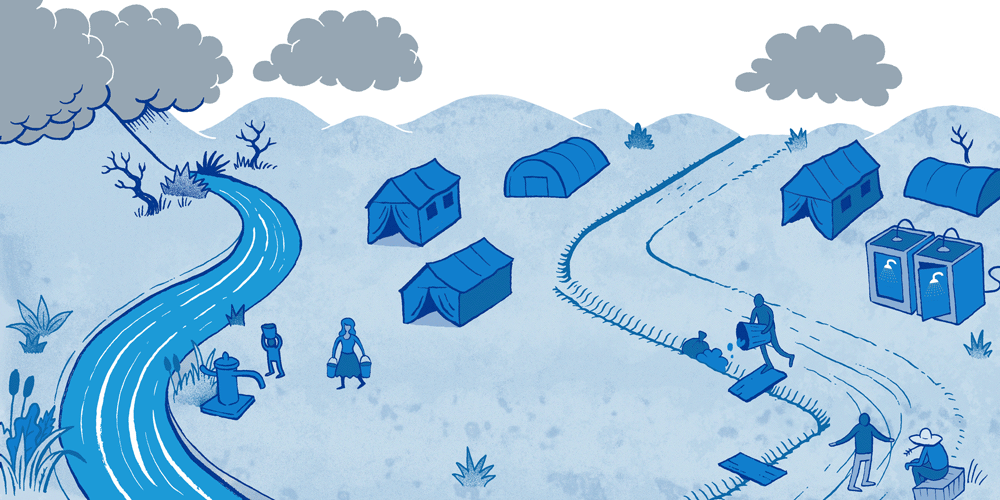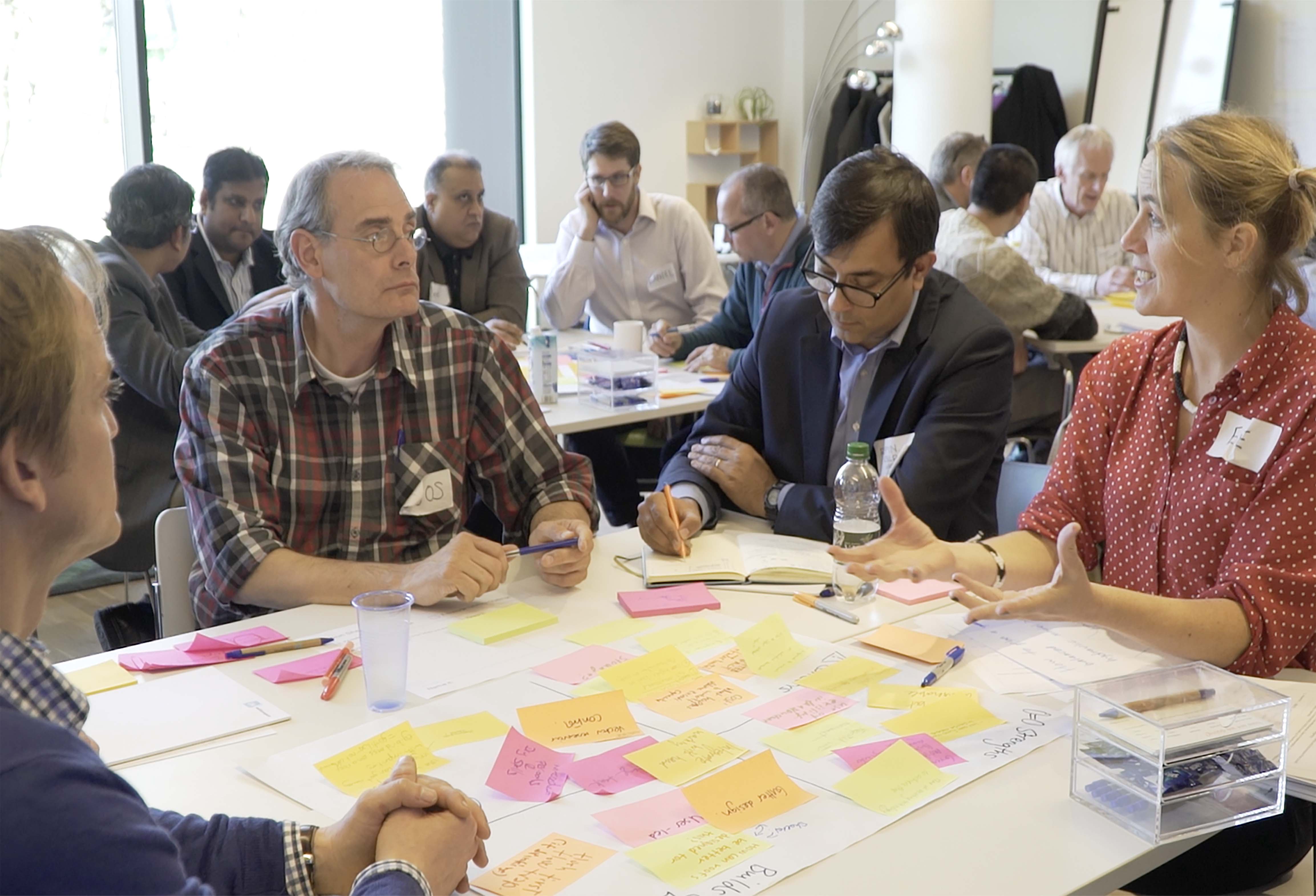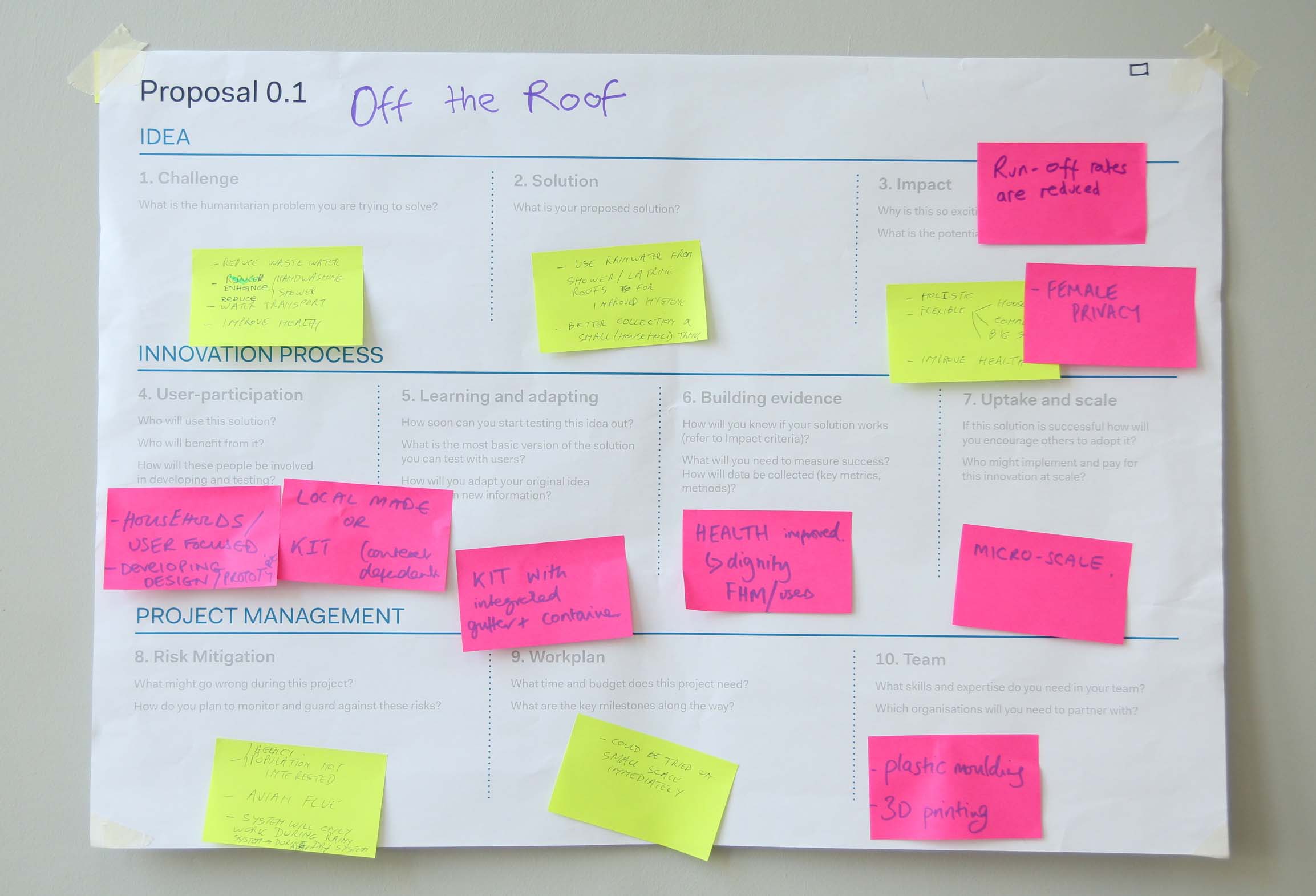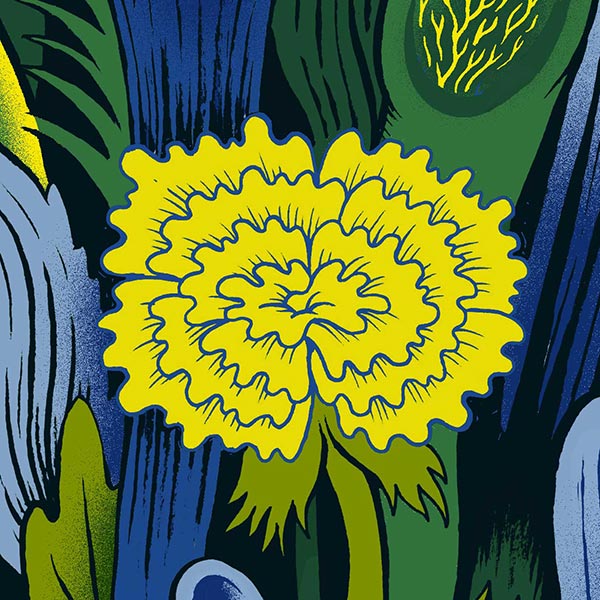What are we trying to get them to do with this activity? Will it take too long? What if we work backwards from the application form? What is the main message of the day? How can we encourage iterative thinking?… We need how many post-its?!
We had a lot of questions.
The aim of these questions was to help us design the launch event of the Humanitarian Innovation Fund (HIF)’s Surface Water Drainage Challenge. Over the past couple of months we’ve been working together with the HIF to help them design six challenges in emergency Water, Sanitation and Hygiene (WASH). The scope of this event was to raise awareness of a relatively overlooked challenge in the humanitarian sector, encourage collaborations, and support the development of strong proposals.
This wasn’t the first event we were organising, but it was definitely one of the largest and most open ones. We’re used to designing and running expert workshops where we present a version of what we think a challenge or a prize could look like and then get ready for the experts to tear it apart and help us build a better one. We’re confident with this process as it involves us asking the questions and getting feedback on a clearly defined output. This was something else.

Causes, effects and potential solutions for Surface Water Drainage in a humanitarian emergency.
Surface Water Drainage (SWD) is an important but rarely addressed issue in a humanitarian emergency. Surface water pooling can be a result of storms or overflowing rivers, as well as poor drainage around water tap stands or water tanks. This water can have a major impact on people’s health but also on their self-esteem and dignity. Having to address this problem in an emergency represents additional challenges because of limited funding, available technical skills and time.
Through several rounds of expert engagement and iterations we developed the Surface Water Drainage Challenge Statement. Now, all we had to do was launch it.
.@the_hif's very own @menka lays out the compelling need for innovation in the humanitarian sector. pic.twitter.com/Qd1cElFx7Z
— Kim Scriven (@KimScriven) April 5, 2016
Shaping ideas to improve drainage in humanitarian emergencies. @The_HIF #unblocking innovation pic.twitter.com/GAWu7glLou
— Science Practice (@sciencepractice) April 5, 2016
The Launch
There are many ways to launch a Challenge. These can range from large public-facing events, to the simple publishing of a call for proposals on a site. Deciding on the best suited approach depends on the aims of the Challenge, the types of solutions sought, likely number of applicants, and the resources available. In the case of the SWD Challenge, we decided to hold a small ideation workshop with key stakeholders and potential applicants (around 30-40 people). The aim was to meet the following objectives:
-
Create a shared understanding of the problem: SWD is not a well-understood problem among humanitarian practitioners, let alone those outside the sector. To help raise awareness of this challenge we brought together drainage experts, researchers, consultants, product manufacturers, designers and humanitarian practitioners, to share their experiences, their understanding of the problem, and in doing so, develop a common understanding of it.
-
Encourage the development of collaborations: Because of the complexity of the problem of SWD in emergencies, we wanted to emphasize on the need to develop robust and diverse teams with a wide range of skills and expertise that could effectively try to tackle the challenge. By bringing people from different backgrounds in the same room, and encouraging them to think about solutions together, we wanted to facilitate the process of developing successful collaborations.


Ideas generated at the launch can be found on the HIF's SWD Challenge Page and here (.pdf).
-
Encourage a design-thinking approach: The HIF were keen to push applicants to think in a more iterative approach about developing solutions. To do so we helped them simplify the application form, made it more concise and emphasized two key elements - user engagement, and learning and adapting. The focus on user engagement implied that involving users in the initial phases of developing solutions was a core requirement, while the focus on learning and adapting asked applicants to think about how to best integrate the feedback received and build upon it. These two elements were also included in the design of the workshop, where participants were asked to come up with potential project ideas, get feedback from the group, iterate, and then receive feedback from a panel of mentors.
-
Familiarise participants with the application process: The risk in simply launching a call for proposals is that applicants often have a template form or a specific solution in mind that they will try to fit around the new call. Having a workshop launch meant that we had an opportunity to present the specific details of the challenge, answer questions and give clarifications. We could highlight the types of solutions the HIF were interested in seeing, and the core elements to focus on when submitting the application. Ultimately, the most important objective for the HIF was to receive strong proposals.
We've been at the @The_HIF launch of the Surface Drainage Challenge today identifying gaps in tools and knowledge! pic.twitter.com/fiQD98w5Uf
— EWB-UK (@ewbuk) April 5, 2016
Turning people's ideas into action as we wrap up our @The_HIF event w/ @sciencepractice on emergency drainage #WASH pic.twitter.com/ouos8grohi
— Kim Scriven (@KimScriven) April 5, 2016
Outcomes – Reviewing proposals
A three-week application phase followed the launch event. At the end of this, the HIF received a total of 30 proposals. We were really excited when the HIF asked for our help in shortlisting them. While the review is still under way, there is a clear conclusion we can draw from going through the applications – the stronger proposals came from participants who attended the launch event. These showed a good understanding of the problem and put forward relevant, innovative solutions. They also had concrete strategies for involving users in the initial testing and a plan of how to iterate their solutions based on the feedback.
The common oversight of proposals from applicants who didn’t attend the launch was that they overlooked the ‘innovative’ aspect of the Challenge. While these proposals addressed genuinely challenging drainage situations, the solutions proposed were not innovations and thus didn’t meet the HIF’s funding objective.
Take on the challenge: #innovators needed to tackle Surface Water Drainage in Camps https://t.co/oAgwVd9GOW #funding pic.twitter.com/gy84chi14T
— HIF (@The_HIF) April 12, 2016
To improve on
Finally, while the day turned out to be a success and translated into strong applications, there were some things we could improve on next time around.
-
Have the right people in the room: While we made a significant effort to engage and invite people with varying complementary expertise to the launch, we didn’t manage to get a camp planner in the room. The challenges they face and their perspective were missed on the day. Looking ahead, identifying early on key players and making sure they are represented on the day should be a priority.
-
Have a good understanding of what attendees know and what they don’t: It came as a surprise that towards the end of the event some attendees were still asking whether funding will be made available for proposals and if so, how will it be allocated. While this information was made available, we think the remaining confusion was due to the fact that almost half of the attendees hadn’t heard of the HIF prior to the event. While this was great in terms of attracting a new audience to the challenge, we failed to acknowledge that it wasn’t immediately obvious that a humanitarian organisation like the HIF would have the available funding to support innovation projects.
-
Be flexible with the structure of the day: Remember those post-its at the beginning of the blog? We didn’t need all of them. It turns out that we could have cut out some of the activities we had planned as well. And we did. We made some of them shorter, we removed some, and we made others a bit longer because they were generating really useful conversations. In this process, we learned how important it is to pay attention to the audience, understand what they’re feeling and where they’re at, and be prepared to adjust the structure of the day accordingly.
Looking ahead, we’re eagerly waiting to see the shortlisted proposals and what else this exciting WASH project has got in store for us! In the meantime, we’ll leave you with a short overview video of the launch event:
Unblocking Innovation: Launching the Humanitarian Innovation Fund's Surface Water Drainage Challenge from Elrha on Vimeo.
Shoutouts
Amy - for helping us design an engaging experience and making sure the energy was high on the day.
Maik – for the amazing work on the launch video and getting it ready in record time.
Matteo – for the wonderful illustrations that helped us tell the story of the challenge.
WallaceSpace - for the amazing venue (& the endless sweets!).

